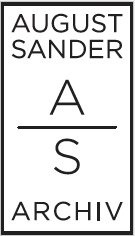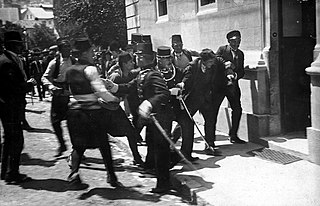Getty Images Holdings, Inc. is a visual media company and supplier of stock images, editorial photography, video, and music for business and consumers, with a library of over 477 million assets. It targets three markets—creative professionals, the media, and corporate.

The Deutscher Werkbund is a German association of artists, architects, designers and industrialists established in 1907. The Werkbund became an important element in the development of modern architecture and industrial design, particularly in the later creation of the Bauhaus school of design. Its initial purpose was to establish a partnership of product manufacturers with design professionals to improve the competitiveness of German companies in global markets. The Werkbund was less an artistic movement than a state-sponsored effort to integrate traditional crafts and industrial mass production techniques, to put Germany on a competitive footing with England and the United States. Its motto Vom Sofakissen zum Städtebau indicates its range of interest.

August Sander was a German portrait and documentary photographer. His first book Face of our Time was published in 1929. Sander has been described as "the most important German portrait photographer of the early twentieth century". Sander's work includes landscape, nature, architecture, and street photography, but he is best known for his portraits, as exemplified by his series People of the 20th Century. In this series, he aims to show a cross-section of society during the Weimar Republic.

Timothy Greenfield-Sanders is an American documentary filmmaker and portrait photographer based in New York City. The majority of his work is shot in large format.

Three Farmers on Their Way to a Dance is Richard Powers' first novel, published in 1985. The novel follows the journeys of three young European boys represented in a c. 1913 or 1914 photograph by August Sander.

The Museum Abteiberg is a municipal museum for contemporary art in the German city Mönchengladbach.

Lothar Wolleh was a well-known German photographer.

The 1910s in Western fashion encompasses styles from 1910 to 1919. Western fashion in this period carries influences from oriental and neoclassical inspirations as well as the subsequent effects of World War I. Over the decade, Women's fashion experienced a shift towards shorter hemlines and dropped waistlines in addition to the more practical garments necessitated by the war. In men's fashion, evening wear largely continued to adhere to previous conventions while trends in informal outerwear continued to evolve. During the period, shifts in fashion made way for styles associated with the Jazz Age of the 1920s.

The Steerage is a black and white photograph taken by Alfred Stieglitz in 1907. It has been hailed by some critics as one of the greatest photographs of all time because it captures in a single image both a formative document of its time and one of the first works of artistic modernism.
There were men and women and children on the lower deck of the steerage. There was a narrow stairway leading to the upper deck of the steerage, a small deck right on the bow with the steamer.
To the left was an inclining funnel and from the upper steerage deck there was fastened a gangway bridge that was glistening in its freshly painted state. It was rather long, white, and during the trip remained untouched by anyone.
On the upper deck, looking over the railing, there was a young man with a straw hat. The shape of the hat was round. He was watching the men and women and children on the lower steerage deck...A round straw hat, the funnel leaning left, the stairway leaning right, the white drawbridge with its railing made of circular chains – white suspenders crossing on the back of a man in the steerage below, round shapes of iron machinery, a mast cutting into the sky, making a triangular shape...I saw shapes related to each other. I was inspired by a picture of shapes and underlying that the feeling I had about life."

The Hofatelier Elvira was a photography studio in Munich founded by jurist and actress Anita Augspurg and friend photographer Sophia Goudstikker in 1887 and is notable as the first company founded by women in Germany. A branch also existed in Augsburg from 1891. They became especially famous for their work in the feminist movement.

Zero was an artist group founded in the late 1950s in Düsseldorf by Heinz Mack and Otto Piene. Piene described it as "a zone of silence and of pure possibilities for a new beginning". In 1961 Günther Uecker joined the initial founders. ZERO became an international movement, with artists from Germany, the Netherlands, Belgium, France, Switzerland, and Italy.

Angelika Platen is a German photographer known internationally for her portraits of artists.
Johann Wilhelm Weimar, known as Wilhelm Weimar, was a German museum scientist, draftsman, typographer and photographer.

Berlin Coal Carrier is a black and white photograph taken by August Sander in 1929. This picture was included in his book Face of Our Time (1931) and was part of his project People of the Twentieth Century, where he pictured several people and professions of Germany.

The August Sander Archive comprises the estate of the German photographer August Sander and is part of the collection of Die Photographische Sammlung/SK Stiftung Kultur, in Cologne. The photographic work has been kept there since 1993 with a large number of original photographs, negatives and documents.

Arrest of a Suspect in Sarajevo, also erroneously identified as The Arrest of Gavrilo Princip, is a historically significant photograph that captured the immediate aftermath of the assassination of Archduke Franz Ferdinand of Austria and his wife Sophie, Duchess of Hohenberg, in Sarajevo on 28 June 1914. Originally believed to depict the apprehension of the assassin, Gavrilo Princip, the image gained widespread attention after appearing on the front cover of the Austrian weekly newspaper Wiener Bilder on 5 July 1914. This portrayal played a crucial role in stirring patriotic sentiments that unified allied nations at the outset of World War I.

Carl Everton Moon was an American photographer, book and magazine illustrator, painter and writer focused on Native American subjects. He has been called "the imitator of Edward Curtis" and "the last of the great early photographers to go west".

View from Williamsburg, Brooklyn, on Manhattan, 9/11 is a color photograph by German photographer Thomas Hoepker. It shows five people sitting on the banks of the East River in the Williamsburg neighborhood of the New York City Borough of Brooklyn while a cloud of smoke rises over Manhattan in the background. It emanates from the collapsed towers of the World Trade Center, which had been the target of a terrorist attack that day.
Working Students is a black and white photograph by German photographer August Sander, taken in 1926. The photograph depicts a group of four students, who also worked for a living, from the Weimar Republic. It was included in his photography landmark book Antlitz der Zeit (1929), and became one of the most famous pictures that Sander took back then.
The Painter Anton Räderscheidt is a black and white photograph taken by German photographer August Sander, in 1926. It depicts the painter Anton Räderscheidt, a member of the New Objectivity artist movement, in a street of Cologne. It was included in his book Face of Our Time (1929).
















